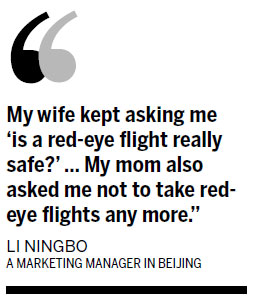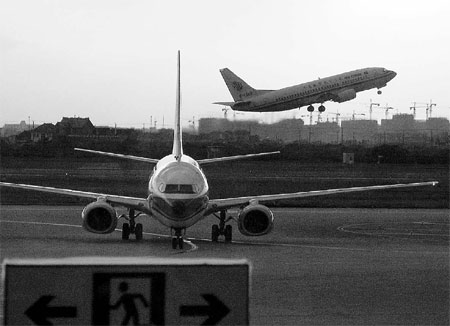Red-eye flights lose their appeal
Updated: 2014-04-06 08:05
By Zhao Lei(China Daily)
|
|||||||
But experts say there is no evidence showing these flights have higher risks.
For Li Ningbo, a 39-year-old marketing manager in Beijing, reassuring his worried wife and parents has become a new part of his job.
"My job extensively involves business trips to foreign countries especially Southeast Asian nations," said Li, who works for a private company that is striving to develop business in Vietnam, Singapore and Malaysia.
"I tend to choose red-eye flights because their tickets are usually cheaper than those that take off in the daytime, which saves money for my company. You know, bosses are sensitive about cost of trips," he said. "Another reason is that my superior always wants me to report to him as soon as I return to Beijing so it appears to him that a red-eye flight is the best way to make the most of my time."
The energetic manager said he does not mind red-eye flights because "compared to the noise during daytime flights, I kind of like the quieter cabin environment of the red-eye, which enables me to meditate, something I don't have time to do during my busy daily routines".
However, for Li's wife and his parents in Hubei province, Li's flying at night has become a worrying issue since a red-eye flight from Kuala Lumpur to Beijing disappeared on March 8.
"My wife kept asking me questions like 'is this flight one that you often took?' or 'is a red-eye flight really safe?' over that weekend," Li recalled. "My mom also called me, asking me not to take red-eye flights any more."
He told them not to worry about the safety of red-eye flights and that he will choose more daytime flights, "but I know they are still concerned."
Malaysia Airlines Flight MH370, a milk run that shuttled many Chinese tourists between Kuala Lumpur and Beijing, has been missing for nearly a month.
Though the Malaysian Prime Minister Najib Razak announced on March 24 that the aircraft crashed into the southern Indian Ocean and there were no survivors, an international search operation involving nearly 20 nations and regions is still racing with time to find the whereabouts of the Boeing 777 aircraft, which has become perhaps one of the most mysterious incidents in civil aviation history.
Li is not the only one taking more daytime flights since the disappearance of MH370. An Qing, an office worker in Shanghai, said the incident has aggravated her reluctance to take night flights.
"My company has tightened the control on our trip expenditure since last year so all employees were told to take flights with cheap fares for business trips," she said.
"Flying at night is exhausting and subject to more safety risks, therefore I'd rather travel by train than take a red-eye flight. Unfortunately, there are no rail services that can directly take me to Bangkok or Manila."
Even Peng Shuai, a famous Chinese tennis player who won the ladies' double championship with Hsieh Su-wei from Taiwan at the 2013 Wimbledon Championships, said she was so terrified she started to cry during a latest red-eye flight.
"During the flight from Indian Wells (in California) to Miami, the aircraft encountered two strong turbulences and it was like the wings were drastically shaking," she told Guangzhou Daily. "It was very scary. As I grasped the safety belt, the MH370 incident came into my mind, and I began to cry."
Adding to the jitters about red-eye flights, another overnight service, Malaysia Airlines Flight MH066 from Kuala Lumpur to Incheon, South Korea, was forced to make an unscheduled landing in Hong Kong on late Monday after a technical fault involving an onboard generator.
The company said that electrical power continued to be supplied by the Airbus A330-300's auxiliary power unit.
The flight departed from Kuala Lumpur at 11:37 pm and was scheduled to arrive in Incheon at 6:50 am local time.
All 271 passengers were transferred to other carriers, the airline said, while the return flight from Incheon to Kuala Lumpur was cancelled.
Nearly 90 percent of respondents polled by an online survey by China Tourism News said they will hesitate to choose red-eye flights in the future or even avoid them.
However, the survey, which did not disclose the number of respondents, shows more than 50 percent of respondents had no experience of flying overnight.
No compromise on safety
In fact, aviation experts say red-eye flights should be as safe as daytime services if airlines strictly follow the rules and ensure their pilots have enough rest.
There is no evidence showing red-eye flights have higher safety risks, said Song Wenbin, a researcher at Shanghai Jiao Tong University's School of Aeronautics and Astronautics.
"Aviation authorities and airlines have strict rules governing the hours pilots can fly and their work schedules, so pilots should have enough rest. No one can afford to violate these rules as they risk having their license revoked," he said. "All requirements for red-eye flights are basically identical to those for daytime services."
Song also noted that the autopilot, satellite positioning and instrument-landing systems on modern aircraft can be trusted to guarantee the planes have safe takeoffs and landings, as well as flights.
"I am in a suitable position to assure you that red-eye flights are as safe as daytime ones," said a captain with a Chinese airline who wished to be identified as Hao. "Moreover, they have some advantages. For instance, less civil aviation aircraft will fly in the same airspace late at night, leaving more space for each flight."
"Air currents at night is also steadier than in daytime," he continued. "For modern civilian aircraft that are highly dependent on autopilots, flying at night is no different from operating in the daytime when it comes to safety."

In the absence of an official definition, the term "red-eye flight" can be used to refer to any flight departing late at night and arriving early the next morning.
It is believed that the term came into being in the United States in 1959 and derived from the fatigue symptom of having red eyes, which can be caused or aggravated by late-night travel.
Chinese passengers' confusion over red-eye flights was magnified after a self-proclaimed civil aviation insider posted a number of suggestions on the Internet right after the MH370 incident, asserting that people should avoid taking red-eye flights due to several reasons.
"(Red-eye flights) fly with low visibility and higher safety hazards. Some safety problems were discovered by passengers who saw smoke from the engine or leaking fuel near the wings, but how would they see them in the night?" the writer claimed. "In addition, pilots and cabin crew flying red-eye flights are more likely to suffer from lack of sleep, resulting in an impaired reaction to possible emergencies."
The Chinese civil aviation authority had banned red-eye flights for nearly four years after May 2002 when a domestic flight from Beijing to Dalian in Liaoning province crashed, killing all the passengers and crew members.
Though investigators concluded that the flight, which was actually operated at night and not exactly a red-eye, ended up crashing because of a criminal act, civil aviation authorities decided to halt all late-night flights in consideration of safety concerns.
In March 2006, the Civil Aviation Administration of China, stimulated by market demand and heavy pressure from overcrowded airports in major cities, partially lifted the ban, allowing flights to run till 2 am in domestic airports.
Two years later, the administration finally removed the restriction on red-eye flights to help tens of thousands of passengers stranded at airports hit by record-breaking winter storms.
All pilots flying commercial aircraft must have received training on overnight flights before obtaining their license, according to Wang Ya'nan, deputy editor-in-chief of Aerospace Knowledge magazine in Beijing.
zhaolei@chinadaily.com.cn
|
The term "red-eye flight" can be used to refer to any flight departing late at night and arriving early the next morning. Provided to China Daily |
(China Daily 04/06/2014 page8)
